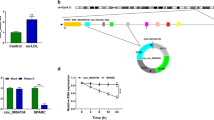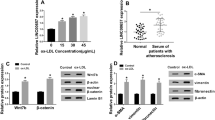Abstract
Background
Circular RNAs (circRNAs) have shown important regulatory roles in cardiovascular diseases, including atherosclerosis (AS). However, the role and mechanism of circ_0026218 in AS remain unclear.
Methods
The cell model of AS in vitro was established by stimulating human umbilical vein endothelial cells (HUVECs) with oxidized low-density lipoprotein (ox-LDL). In addition, circ_0026218, microRNA-188-3p (miR-188-3p), and toll-like receptor 4 (TLR4) expression was determined via real-time quantitative polymerase chain reaction (RT-qPCR) in serum samples from AS patients and healthy volunteers. Cell proliferation was assessed using Cell Counting Kit-8 (CCK-8) assay and 5-ethynyl-2’-deoxyuridine (EdU) assay. Cell apoptosis was measured using flow cytometry. The inflammatory response was assessed using enzyme-linked immunosorbent assay (ELISA). Oxidative stress level was assessed using corresponding kits. Nitric oxide (NO) level was examined using NO detection assay. The interaction between miR-188-3p and circ_0026218 or TLR4 was determined via dual-luciferase reporter, RNA immunoprecipitation (RIP), and RNA pull-down assays. Exosomes were observed using transmission electron microscopy (TEM). The size distribution of exosomes was analyzed using nanoparticle tracking analysis (NTA).
Results
Ox-LDL treatment caused HUVEC dysfunction by inhibiting cell proliferation and promoting apoptosis, inflammation, and oxidative stress. Circ_0026218 was upregulated in AS serum samples and ox-LDL-treated HUVECs. Knockdown of circ_0026218 attenuated ox-LDL-induced dysfunction in HUVECs. MiR-188-3p acted as a target of circ_0026218, and miR-188-3p downregulation reversed the suppression role of circ_0026218 knockdown on ox-LDL-induced HUVEC disorder. TLR4 was a target of miR-188-3p, and miR-188-3p overexpression alleviated ox-LDL-induced dysfunction in HUVECs by targeting TLR4. Circ_0026218 could deregulate the TLR4/NF-κB pathway by sponging the miR-188-3p. Importantly, circ_0026218 was overexpressed in exosomes from ox-LDL-treated HUVECs and could be delivered via exosomes.
Conclusion
Circ_0026218 knockdown attenuated ox-LDL-induced dysfunction in HUVECs via regulating miR-188-3p/TLR4/NF-κB pathway.










Similar content being viewed by others
Data availability
Not applicable.
References
Weber C, Noels H. Atherosclerosis: current pathogenesis and therapeutic options. Nat Med. 17:1410–22.
Santovito D, Weber C. Atherosclerosis revisited from a clinical perspective: still an inflammatory disease? Thromb Haemost. 2017;117:231–7.
Gimbrone MA Jr, García-Cardeña G. Endothelial cell sysfunction and the pathobiology of atherosclerosis. Circ Res. 2016;118:620–36.
Pirillo A, Norata GD, Catapano AL. LOX-1, OxLDL, and atherosclerosis. Mediators Inflamm. 2013;2013:152786.
Gao S, Zhao D, Wang M, et al. Association between circulating oxidized LDL and atherosclerotic cardiovascular disease: a meta-analysis of observational studies. Can J Cardiol. 2017;33:1624–32.
Takenaka T, Takahashi K, Kobayashi T, Oshima E, Iwasaki S, Suzuki H. Oxidized low density lipoprotein (Ox-LDL) as a marker of atherosclerosis in hemodialysis (HD) patients. Clin Nephrol. 2002;58:33–7.
Liu J, Liu T, Wang X, He A. Circles reshaping the RNA world: from waste to treasure. Mol Cancer. 2017;16:58.
Chen LL. The biogenesis and emerging roles of circular RNAs. Nat Rev Mol Cell Biol. 2016;17:205–11.
Arnaiz E, Sole C, Manterola L, Iparraguirre L, Otaegui D, Lawrie CH. CircRNAs and cancer: Biomarkers and master regulators. Semin Cancer Biol. 2019;58:90–9.
Vo JN, Cieslik M, Zhang Y, Shukla S, Xiao L, Zhang Y, et al. The landscape of circular RNA in cancer. Cell. 2019;176:869–81.e13.
Kong P, Yu Y, Wang L, et al. circ-Sirt1 controls NF-κB activation via sequence-specific interaction and enhancement of SIRT1 expression by binding to miR-132/212 in vascular smooth muscle cells. Nucleic Acids Res. 2019;47:3580–93.
Altesha MA, Ni T, Khan A, Liu K, Zheng X. Circular RNA in cardiovascular disease. J Cell Physiol. 2019;234:5588–600.
Huang HS, Huang XY, Yu HZ, Xue Y, Zhu PL. Circular RNA circ-RELL1 regulates inflammatory response by miR-6873-3p/MyD88/NF-κB axis in endothelial cells. Biochem Biophys Res Commun. 2020;525:512–9.
Gu Y, Ma X, Li J, Ma Y, Zhang Y. Identification of candidate targets for the diagnosis and treatment of atherosclerosis by bioinformatics analysis. Am J Transl Res. 2021;13:4137–51.
Han B, Chao J, Yao H. Circular RNA and its mechanisms in disease: from the bench to the clinic. Pharmacol Ther. 2018;187:31–44.
Juźwik CA, Drake SS, Zhang Y, et al. microRNA dysregulation in neurodegenerative diseases: A systematic review. Prog Neurobiol. 2019;182:101664.
Andreou I, Sun X, Stone PH, Edelman ER, Feinberg MW. miRNAs in atherosclerotic plaque initiation, progression, and rupture. Trends Mol Med. 21:307–18.
Peng W, Li S, Chen S, Yang J, Sun Z. Hsa_circ_0003204 knockdown weakens Ox-LDL-Induced cell injury by regulating miR-188-3p/TRPC6 axis in human carotid artery endothelial cells and THP-1 cells. Front Cardiovasc Med. 2021;8:731890.
Gu S, Jin L, Zhang F, Sarnow P, Kay MA. Biological basis for restriction of microRNA targets to the 3' untranslated region in mammalian mRNAs. Nat Struct Mol Biol. 2009;16:144–50.
de Vicente LG, Pinto AP, da Rocha AL, Pauli JR, de Moura LP, Cintra DE, et al. Role of TLR4 in physical exercise and cardiovascular diseases. Cytokine. 2020;136:155273.
Hansen TB, Jensen TI, Clausen BH, et al. Natural RNA circles function as efficient microRNA sponges. Nature. 2013;495:384.
Galkina E, Ley K. Immune and inflammatory mechanisms of atherosclerosis (*). Annu Rev Immunol. 2009;27:165–97.
Tousoulis D, Simopoulou C, Papageorgiou N, et al. Endothelial dysfunction in conduit arteries and in microcirculation. Novel therapeutic approaches. Pharmacol Ther. 2014;144:253–67.
Davignon J, Ganz P. Role of endothelial dysfunction in atherosclerosis. Circulation. 2004;109:Iii27–32.
Park HJ, Zhang Y, Georgescu SP, Johnson KL, Kong D, Galper JB. Human umbilical vein endothelial cells and human dermal microvascular endothelial cells offer new insights into the relationship between lipid metabolism and angiogenesis. Stem Cell Rev. 2006;2:93–102.
Zhang Y, Zhang X-O, Chen T, et al. Circular intronic long noncoding RNAs. Mol Cell. 2013;51:792–806.
Ng WL, Mohd Mohidin TB, Shukla K. Functional role of circular RNAs in cancer development and progression. RNA Biol. 2018;15:995–1005.
Wan H, You T, Luo W. Circ_0003204 regulates cell growth, oxidative stress, and inflammation in ox-LDL-induced vascular endothelial cells via regulating miR-942-5p/HDAC9 axis. Front Cardiovasc Med. 2021;8:646832.
Chen W, Guo S, Li X, Song N, Wang D, Yu R. The regulated profile of noncoding RNAs associated with inflammation by tanshinone IIA on atherosclerosis. J Leukoc Biol. 2020;108:243–52.
Wang G, Li Y, Liu Z, et al. Circular RNA circ_0124644 exacerbates the ox-LDL-induced endothelial injury in human vascular endothelial cells through regulating PAPP-A by acting as a sponge of miR-149-5p. Mol Cell Biochem. 2020;471:51–61.
Zhang C, Wang L, Shen Y. Circ_0004104 knockdown alleviates oxidized low-density lipoprotein-induced dysfunction in vascular endothelial cells through targeting miR-328-3p/TRIM14 axis in atherosclerosis. BMC Cardiovasc Disord. 2021;21:207.
Pei J, Zhang J, Yang X, et al. TMED3 promotes cell proliferation and motility in breast cancer and is negatively modulated by miR-188-3p. Cancer Cell Int. 2019;19:75.
Luo Z, Fan Y, Liu X, et al. MiR-188-3p and miR-133b suppress cell proliferation in human hepatocellular carcinoma via post-transcriptional suppression of NDRG1. Technol Cancer Res Treat. 2021;20:15330338211033074.
Mi S, Wang P, Lin L. miR-188-3p inhibits vascular smooth muscle cell proliferation and migration by targeting fibroblast Ggrowth factor 1 (FGF1). Med Sci Monit. 2020;26:e924394.
Zhang XF, Yang Y, Yang XY, Tong Q. MiR-188-3p upregulation results in the inhibition of macrophage proinflammatory activities and atherosclerosis in ApoE-deficient mice. Thromb Res. 2018;171:55–61.
Fabian MR, Sonenberg N, Filipowicz W. Regulation of mRNA translation and stability by microRNAs. Annu Rev Biochem. 2010;79:351–79.
Yang K, He YS, Wang XQ, et al. MiR-146a inhibits oxidized low-density lipoprotein-induced lipid accumulation and inflammatory response via targeting toll-like receptor 4. FEBS Lett. 2011;585:854–60.
Du XJ, Lu JM. MiR-135a represses oxidative stress and vascular inflammatory events via targeting toll-like receptor 4 in atherogenesis. J Cell Biochem. 2018;119:6154–61.
Yang K, Xue Y, Gao X. LncRNA XIST promotes atherosclerosis by regulating miR-599/TLR4 axis. Inflammation. 2021;44:965–73.
Lawrence T. The nuclear factor NF-kappaB pathway in inflammation. Cold Spring Harb Perspect Biol. 2009;1:a001651.
Balzan S, Lubrano V. LOX-1 receptor: a potential link in atherosclerosis and cancer. Life Sci. 2018;198:79–86.
Cocucci E, Meldolesi J. Ectosomes and exosomes: shedding the confusion between extracellular vesicles. Trends Cell Biol. 2015;25:364–72.
Vlassov AV, Magdaleno S, Setterquist R, Conrad R. Exosomes: current knowledge of their composition, biological functions, and diagnostic and therapeutic potentials. Biochim Biophys Acta. 2012;1820:940–8.
Ge R, Tan E, Sharghi-Namini S, Asada HH. Exosomes in Cancer Microenvironment and Beyond: have we overlooked these extracellular messengers? Cancer Microenviron. 2012;5:323–32.
Li Y, Feng W, Kong M, et al. Exosomal circRNAs: a new star in cancer. Life Sci. 2021;269:119039.
Funding
Funding was provided by Natural Science Foundation of Xinjiang Uygur Autonomous Region (2018D01C219).
Author information
Authors and Affiliations
Contributions
Xiangyang Zhang designed and performed the research; Zhaoxia Yu and Tieliang Zhang analyzed the data; Jing Liu wrote the manuscript. All authors read and approved the final manuscript.
Corresponding author
Ethics declarations
Ethics approval and consent to participate
Written informed consents were obtained from all participants, and this study was permitted by the Ethics Committee of First Affiliated Hospital of Xinjiang Medical University.
Consent for publication
Not applicable.
Conflict of interest
The authors declare that they have no conflict of interest.
Additional information
Publisher’s Note
Springer Nature remains neutral with regard to jurisdictional claims in published maps and institutional affiliations.
Supplementary information

ESM 1
Knockdown of circ_0026218 abolished ox-LDL-induced NO level repression in HUVECs. HUVECs were divided into four groups: Control (without ox-LD), ox-LDL (50 μg/mL), ox-LDL+si-NC, and ox-LDL+si-circ_0026218. NO level was assessed in HUVECs using NO detection assay (one-way ANOVA). **P < 0.01, ***P < 0.001. (PNG 13 kb)
Rights and permissions
Springer Nature or its licensor (e.g. a society or other partner) holds exclusive rights to this article under a publishing agreement with the author(s) or other rightsholder(s); author self-archiving of the accepted manuscript version of this article is solely governed by the terms of such publishing agreement and applicable law.
About this article
Cite this article
Liu, J., Zhang, X., Yu, Z. et al. Circ_0026218 ameliorates oxidized low-density lipoprotein-induced vascular endothelial cell dysfunction by regulating miR-188-3p/TLR4/NF-κB pathway. Cardiovasc Drugs Ther 38, 263–277 (2024). https://doi.org/10.1007/s10557-022-07416-x
Accepted:
Published:
Issue Date:
DOI: https://doi.org/10.1007/s10557-022-07416-x




